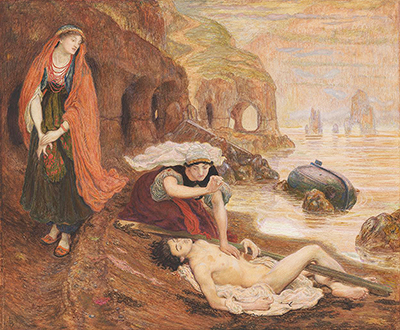The painting, The Finding of Don Juan by Haidee, was created out of Brown's illustration for The Poetical work of Lord Byron, between 1869 and 1870.
It is a watercolor and gouache over pencil painting. Its location was in London, England. It depicts a scene from the poem Don Juan in which Haidee, the daughter of a greek pirate, and her maid Zoe discover the lifeless body of Juan on a beach The Finding of Don Juan by Haidee constitutes of watercolor and gouache in creating the brilliant shades of the sky and the sea, reflected by the setting sun, which creates a shadow of the rich color of the exotic garments, the seaweed strewed shoreline and the eroded cliffs.
In the painting, The Finding of Don Juan by Haidee, the richly dressed figure is that of Zoe, Haidee's maid. Her stance is counterposed by that of her mistress's urgent gestures. The horizontal line of Haidee's flowing veil and raised arm draws the attention of the view to Don Juan's naked form, her rosy hand contrasting with his deathly pale skin. The colors in the paint are harmonious and blend very well. They are earthly, vivid and dark. They compliment strongly to the background of the paint as the viewers eye moves from the subjects of the paint and are taken further back in to cliffs. However, the color used for the male figure is light and in contrast to the rest of the elements in the paint. It is highly notable. The atmosphere of the paint is gloomy, distressing and thought provoking.
Among the people who inspired Ford Madox Brown are Lord Byron himself, with his poem, the artists he associated with throughout his contact with the Pre Raphaelite Brotherhood where he adopted the bright colors and the realistic style of painting, the work of Holbein that he came across in Basel in 1845 and by Friedrich Overbeck and Pater Cornellius whom he met in Rome between 1845 and 1846. Also, he was profoundly inspired by the Pre raphaelite sculptor Thomas Woolner in his most famous work of The Last of England. He inspired Gabriel Rossetti who became his tutor and also a lifelong friend and admirer of his work. His other notable work include Work ( Manchester) in 1865, The Seeds and Fruit of English Poetry in 1845, Chaucer at the Court of Edward III between 1847 and 1851, The last of England in 1860, Jacob and Josephs coat in 1871, Romeo and Juliet between 1868 and 1871 and Jesus washing Peters Feet in 1876.




